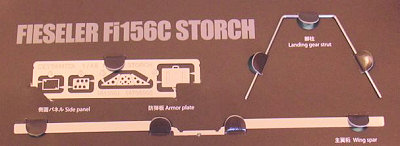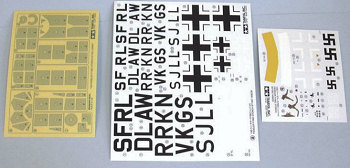
Tamiya 1/48 Fi-156 'Storch'
| KIT: | Tamiya 1/48 Fi-156 'Storch' |
| KIT #: | 61100 |
| PRICE: | 5200 yen at www.hlj.com |
| DECALS: | Five options |
| REVIEWER: | Tom Cleaver |
| NOTES: | Two Rommel figures included. |

| HISTORY |
So ubiquitous was the Fieseler Fi-156 Storch that it was said that “wherever the Wehrmacht was to be found, there also was the Storch.” The Fi-156, which is still a high-performance STOL aircraft 71 years after it was first designed, and capable of flying feats few other aircraft can perform, was the epitome of what 1930s army co-operation aircraft should be.
First designed in 1935, the Fi-156 first flew in 1936 and offered outstanding low sped and short-takeoff-and-landing (STOL performance, demonstrating a takeoff distance of 200 feet with the ability to come to a full stop in a landing in 66 feet with just a light breeze. The aircraft achieved this performance with a fixed Handley-Page slat on the leading edge of the wing, with huge flaps that could be deployed at any desired angle, along with ailerons that drooped during landing. The Storch could be flown as slow as 32 mph under full control in still air.
While Messerschmitt, Focke-Wulf, and Siebel entered the design competition announced by the RLM following the successful test flights of the privately-designed Storch, with Focke-Wulf entering an autogyro, the little Storch beat them all.
Adopted by the Luftwaffe in 1937, the Storch entered production as the Fi-156A-1 in 1938,with 229 delivered in 1939. The Storch first saw combat in Spain as a liaison and staff transport in late 1938, and was exported Finland, Switzerland and even the Soviet Union. The aft-firing MG 15 appeared in late 1938 on the Fi-156C-0, and the C series became the Luftwaffe’s primary equipment.
In combat in 1939-40, the Storch made its reputation for rescuing shot-down pilots in combat zones and as an evacuation ambulance for wounded, in addition to its work as a battlefield reconnaissance aircraft.
In 1941, small numbers were provided to Bulgaria, Hungary, Croatia and Romania, with production centering on the Fi-156C-3, which could be used as an ambulance, or for battlefield reconnaissance or as a staff transport.
Fieseler was forced eventually to move production of the Storch to make room for the production lines dedicated to the Bf-109 and Fw-190, and moved production to Morane-Saulnier in France in 1942, where it continued in production postwar as the M.S.500 Criquet. The airplane was also produced by Mraz in Czechoslovakia beginning in 1943, where it also continued in production postwar as the K-65 Cap. The French Criquet was used in combat by the South Vietnamese Air Force as late as 1962 and Storchs were fairly common throughout Europe as glider tugs.
The airplane gained a measure of fame as the favored aerial transport for Field Marshal Erwin Rommel in North Africa, but it is primarily remembered in history for its role in the daring rescue of the imprisoned Benito Mussolini on September 12, 1943 by Otto Skorzeny’s commandos. Mussolini had been arrested and imprisoned when the Fascist state was overthrown on September 5, 1943, following the invasion of Salerno. At first Mussolini’s whereabouts were unknown, but Skorzeny finally located the dictator at the hotel on the Gran Sasso Massif in the Abruzzi Molise. The hotel, accessible only by cable car, was at an altitude of 9,050 feet. Skorzeny originally planned to use a Focke-Achgelis Fa-223 helicopter to make the raid, but it went unserviceable just before the mission. The commandos then used a Storch, which had to land on the flat part of the hotel roof, which was only 150 feet long, and then take off in overloaded condition, which it did successfully.
The Storch also was famous in Allied service. Air Vice Marshal Harry Broadhurst had used a “pet Storch” - an Fi-156C-3/Trop - as his personal airplane after it was captured in North Africa in 1943 when he headed the Desert Air Force, and he brought it to England in 1944 when he took command of 83 Group in 2nd Tactical Air Force for the coming invasion. On June 10, 1944, Broadhurst flew Prime Minister Winston Churchill across the Channel into Normandy, landing at the first airstrip to be readied inside the beachhead, thus allowing Churchill to be the first Allied leader to land in Liberated France. Broadhurst continued to fly the airplane until it was lost in an accident in April 1945.
The Storch was also the last German aircraft shot down in air combat on the Western Front, on the morning of V-E Day. Lieutenants Duane Francies and William Martin, flying a Piper L-4 Cub for the 5th US Army Division, spotted a Storch circling below them. They immediately dove on the airplane and opened fire with their Colt .45s, with the result that the Storch made a emergency landing with its engine hit. The Americans landed their Cub and - following a short gun battle - captured the two Germans. Observer Martin won the Air Medal for his role, but pilot Duane Francies had to wait 22 years until the story was told in Cornelius Ryan's book, "The Last Battle," before he was awarded the Distinguished Flying Cross. While it was the last Luftwaffe plane lost on the western front, this Storch was also the only German plane shot down by pistol fire during the Second World War.
| THE KIT |
 Over the past six months or so, there has been considerable discussion at the
scale muddling discussion boards about what Tamiya would release as its 100th
1/48 scale airplane kit. The guesses ranged far and wide, with all the usual
suspects mentioned at least 1,000 times each, but no one thought to predict that
Tamiya’s Number 100 would be the Fieseler Storch. I think it possible one could
have heard a pin drop around the planet the day Tamiya announced in early
September that they were releasing an Fi-156 Storch.
Over the past six months or so, there has been considerable discussion at the
scale muddling discussion boards about what Tamiya would release as its 100th
1/48 scale airplane kit. The guesses ranged far and wide, with all the usual
suspects mentioned at least 1,000 times each, but no one thought to predict that
Tamiya’s Number 100 would be the Fieseler Storch. I think it possible one could
have heard a pin drop around the planet the day Tamiya announced in early
September that they were releasing an Fi-156 Storch.
The stunned silence was quickly replaced with “Whaaaaaaaaat the fuuuuuuu.....??????!!!!! Are they out of their minds?????”
This was replaced by “Ooooooh” and “Ahhhhh” when test shots and a model were displayed at the Tokyo Hobby Show in October. But there is still an air of disbelief among modelers that the lowly little Storch would be Kit Number One Hundred from The World’s Leading Plastic Airplane Kit Manufacturer. Liaison aircraft have not exactly been top of the hit parade among modelers over the years. There has also been a very acceptable kit available in 1/48 from ESCI for the past 30 years (though not currently in production) - which also was released as the radial-engined “Criquet” - as well as a very nice kit in 1/32 from Hasegawa, and at least two kits in 1/72 I can think of. And at an MSRP here in The Land of the Devalued Yankee Dollar of $60, even diehard Tamiya fans have had a bit of trouble wrapping their heads around the idea of buying this kit.
Well, for those brave souls who do buy it (and since the Yen is even further in
the tank than the Dollar, doing so at HLJ will get you a pretty substantial
reduction in price), what’s in the box is probably the most advanced plastic
airplane model on the planet, in terms of production design and production
quality.
For starters, the clear parts for the rear canopy sides are molded integrally with the fuselage halves, making it nearly impossible (with some people I can think of, though, one should definitely “never say never”) to misalign the cockpit canopy. The clear parts are really clear, and there is a separate door that can be displayed open.
 Most intriguingly, the design includes a photo-etch spar that will guarantee the
wing is in proper position without having to be glued to the canopy and risk a
gluey fingerprint on that very clear plastic, while there is also a wire part
that provides strength and alignment for the thin, stalky landing gear, which
slides into position over this wire.
Most intriguingly, the design includes a photo-etch spar that will guarantee the
wing is in proper position without having to be glued to the canopy and risk a
gluey fingerprint on that very clear plastic, while there is also a wire part
that provides strength and alignment for the thin, stalky landing gear, which
slides into position over this wire.
The cockpit of a Storch was pretty bare, but what was there is all here in the kit, along with a photoetch instrument panel.
The fabric detail of the airframe parts is some of the best I have seen done by
anyone. The wings come with separate flaps and
 ailerons. A complete Argus
engine is provided with separate cowling panels, so it can be displayed fully
open, partly open, or closed. There are also skis which can replace the wheels
on the landing gear.
ailerons. A complete Argus
engine is provided with separate cowling panels, so it can be displayed fully
open, partly open, or closed. There are also skis which can replace the wheels
on the landing gear.
The kit includes painting masks, which will be very welcome when it comes time to paint all the bay windows on the model.
Decals are provided for five aircraft, including a Fi 156C-3/trop used by Field Marshall Erwin Rommel during 1942, in RLM 79 with a Light Blue squiggle, along with another Fi 156C-3/trop used by Rommel finished in RLM 79 with RLM 78 lower surfaces, as well as the Fi 156C-3 used in the Gran Sasso raid, a Fi 156C-7 from an unknown unit, and an Fi 156C-5 on skis with an auxiliary tank on the Eastern Front in 1942, with a winter whitewash over the standard 70/71/65 finish.
Editor's note: I've shown one representative full sprue. Trust me that the quality is all you have come to expect from Tamiya.
| CONCLUSIONS |
For those who can tear themselves away from building models of Airplanes Flown By Aces, this kit is just about guaranteed to result in a beautiful model out of the box, where the only way for a modeler to screweth the poocheth will be the way they handle their airbrush while painting it. The Storch is a significant airplane, and there are already some interesting aftermarket decals out for the kit, with more to come.
Highly recommended.
Review Kit provided by HobbyLink Japan. Get yours at “Japanese prices” at www.hlj.com
January 2008
If you would like your product reviewed fairly and quickly, please contact me or see other details in the Note to Contributors.